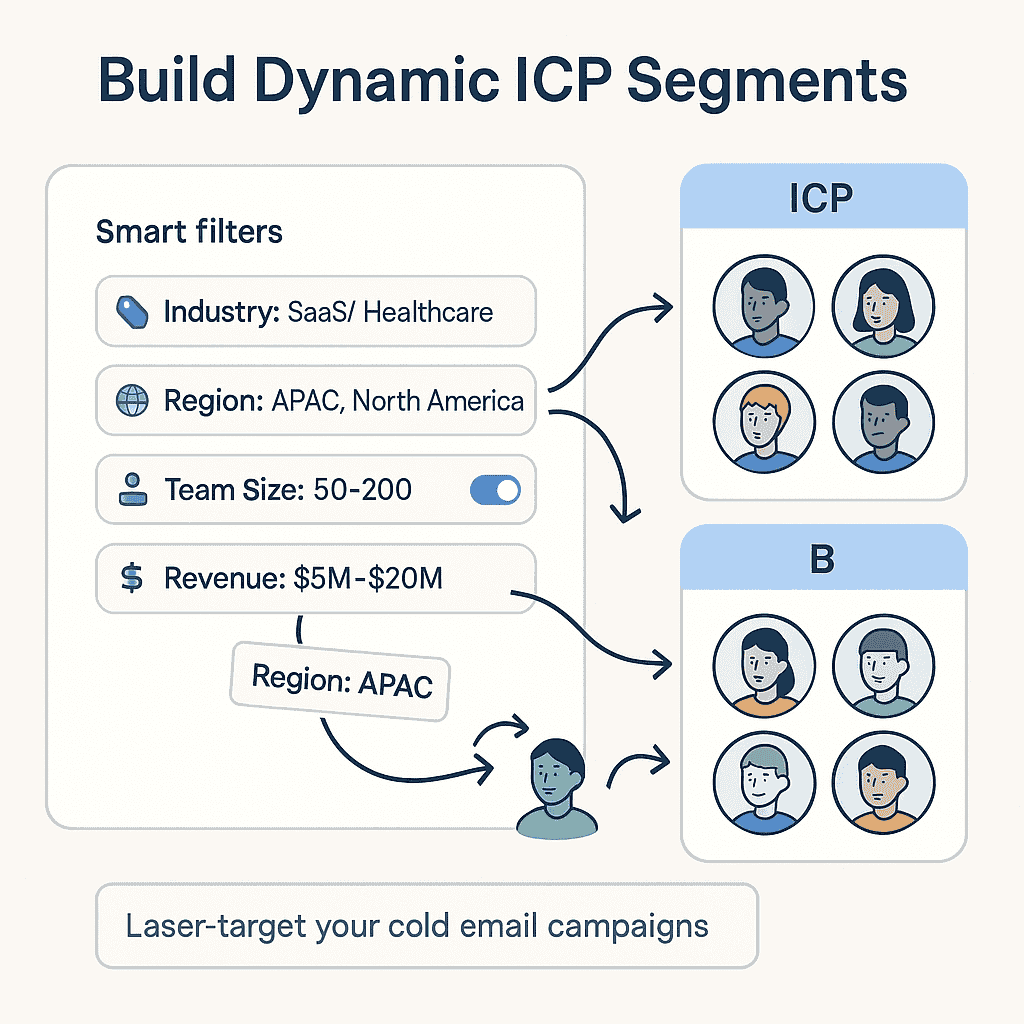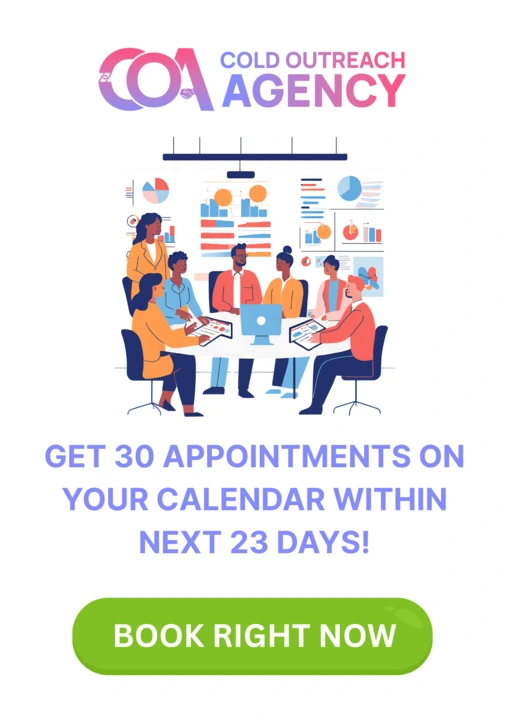When I first started doing cold outreach, I used to make the classic rookie mistake—trying to reach everyone. I’d send emails to every business owner, freelancer, marketer, coach, or consultant under the sun, hoping someone would reply.
And yes, a few did. But most didn’t.
It starts with who you’re emailing.
So in this article, I’ll walk you through how I build and refine ICPs for laser-targeted cold email campaigns that convert. This is the exact process we use at Cold Outreach Agency to help our clients get high-quality appointments, and I’m breaking it all down, step by step.
What Is an Ideal Customer Profile (ICP) and Why It’s Non-Negotiable
Let me put it simply.
An Ideal Customer Profile.
It’s not just demographics. It’s psychographics, firmographics, behavior patterns, pain points, goals, buying triggers, decision-making processes—everything that defines your dream customer.
That’s why ICP is step zero.
Without a well-defined ICP, you’ll waste time, money, and your domain reputation sending irrelevant emails.

Step 1: Reverse Engineer Your Best Clients
Not just revenue-wise, but in terms of ease of communication, repeat business, attitude, fit, and profitability.
Here’s what I do:
Analyze Past Wins
If I’ve already worked with a few clients, I create a list of:
- Clients who paid the most
- Clients who were easiest to work with
- Clients who referred others
- Clients who stayed the longest
Then I break them down. What industry were they in? How big was their team? What was their pain point? What offer did they respond to?
This helps me build a pattern.
For example, I found that marketing agency owners with 3–10 team members, struggling with lead flow, responded best to our AI-personalized cold email outreach offers. So I built an ICP around that.
If You’re Starting from Scratch
If I don’t have previous clients, I research competitors and spy on who they are targeting. I read their case studies, social proof, reviews, and podcast episodes—everything.
Then I built my first version of ICP based on those patterns.
Step 2: Break Down the ICP Using Firmographics and Psychographics
Once I have an initial sense of who I want to target, I get more specific.
I break down the ICP into two parts:
Firmographics (For B2B):
Industry: What niche are they in? SaaS? Ecom? Real Estate?
Company Size: Employees, revenue range, clients served
Buying Triggers: Are they looking to scale? Just raised funding? Struggling with churn?
Decision Makers: Who’s the one making the call? CEO, Founder, Head of Marketing?
Let me give you a quick example:
Bad ICP: “Small businesses that need help with marketing.
Step 3: Talk to Your Target Audience
Talk to your ICP.
Hop on calls, send DMs, or ask for 10-minute chats.
Here’s what I ask:
These words will go into my email copy later. Because when you mirror their language, they feel understood instantly.
Step 4: Use Data to Validate the ICP
After I’ve built the ICP and done qualitative research, I validate it with data.
I use tools like:
Apollo.io
LinkedIn Sales Navigator
BuiltWith
Clay.
Step 5: Build Dynamic ICP Segments
Now, I don’t stop at just one ICP.
Let’s say I’m targeting marketing agencies. That’s one umbrella.
But under that, I can have sub-ICPs:
SEO agency owners
Paid ads consultants
CRO experts
Funnel builders
Branding studios
Each of these subgroups has slightly different pain points. So I create micro ICPs and write tailored messages for each.
That’s where the real magic happens.
Because when I email an SEO agency owner and say,
“Hey [Name], noticed you help clients rank on Google but don’t yet have a system to consistently get 10–15 leads/month for your agency…” They instantly relate.

Step 6: Document Your ICP in a Living Sheet
I always write down everything in a single, shareable sheet or Notion page:
Basic description
Firmographic filters
Psychographic notes
Common objections
Favorite tools
Why?
Because ICP isn’t static. It evolves.
Every 30–60 days, I revisit it. I update based on performance data—who’s replying, who’s booking, who’s converting.
If an ICP segment underperforms, I either:
Refine the offer
Adjust the message
Or ditch that segment
Step 7: Tie the ICP Directly into the Cold Email Strategy
Once I have a solid ICP, my cold outreach becomes surgical.
Here’s how I tie it all together:
List Building
I use tools like Apollo or LinkedIn to scrape and build lists that match the exact ICP filters.
Example: Marketing agency founders → U.S. → 3–10 employees → using ClickFunnels → Founder title → active LinkedIn profile.
That’s a laser-targeted list. No fluff.
Personalization Strategy
Because I know their pain points and goals, I can write the first lines that actually speak to them.
Example: “Hey [Name], saw you help coaches scale with paid ads but noticed your agency isn’t showing up for outbound growth-related keywords—curious if leads are mainly inbound?”
It hits differently when you know who you’re speaking to.
Offer Relevance
A well-defined ICP helps me present the right offer.
No generic “I help you grow your business” stuff.
It’s more like:
“We help SEO agency owners book 10–15 sales calls/month through fully done-for-you cold email systems without hiring SDRs.”
Specific. Relevant. Aligned.
Conclusion: Why Nailing Your ICP Is the Single Most Important Thing You Can Do for Cold Email Success
If you’ve made it this far, you already know this isn’t some “growth hack.” Defining your Ideal Customer Profile (ICP) is a foundational, strategic move—and it’s non-negotiable if you’re serious about building a sustainable outbound system.
Let me give it to you straight: 95% of cold outreach campaigns fail not because the offer sucks, not because your email copy isn’t catchy enough, not because of deliverability issues—but because you’re talking to the wrong people.
Think about it. If you’re a dating coach sending emails to HR managers, or a B2B SaaS trying to pitch your automation tool to local photographers, you’re already setting yourself up to fail. It’s like trying to sell surfboards in the desert. Doesn’t matter how great the product is—you’re not in the right place, speaking to the right people.
And I’ll be honest—I’ve made that mistake more times than I can count.
When I started Cold Outreach Agency, I used to think more outreach = more results. I sent campaigns to general lists, thinking that casting a wider net would catch more fish. In reality, I just wasted time, burned domains, and got replies like “Take me off your list” or worse—no replies at all.
It wasn’t until I took the time to sit down, analyze patterns, reverse-engineer wins, and get ruthlessly specific about who I wanted to help that everything changed.
Let me walk you through how that clarity translates into wins.
1. Your Messaging Hits Hard
- “We help businesses grow.”
You’re saying:
- “We help performance marketing agencies with 3–10 team members struggling to get outbound leads to book 15+ qualified sales calls every month using AI-personalized cold email systems—no extra hires needed.”
That difference? It’s everything.
When a prospect reads your email and thinks, “Damn, this person gets me,” your chances of getting a reply go through the roof.
2. You Build Hyper-Qualified Lists That Convert
The worst feeling? Spending hours writing emails, only to realize your list was trash. Wrong industry, bad job titles, irrelevant needs.
When you have a clear ICP, you can use filters in Apollo, LinkedIn Sales Navigator, Clay, or Instantly to build high-quality lists that perfectly match your ideal audience.
Not just:
> “Marketing agencies in the U.S.”
But:
- “Funnel-building agency founders in California with 5–15 employees, using GoHighLevel, posting on LinkedIn weekly, offering lead-gen services to coaches.”
Now you’re not just list-building—you’re targeting.
3. Your Offer Becomes Irresistible
Another advantage? You can tailor your offer to the person you’re speaking to.
Instead of trying to make one broad offer for everyone, you’re crafting micro-offers for micro-ICPs. That’s how you go from “meh” results to campaigns that print money.
Let me give you a real example from our agency:
We tested two offers:
Generic: “We help marketing agencies generate leads using cold email.”
Specific: “We help SEO agency owners add 10–15 sales calls/month using a fully managed cold email system—without hiring SDRs or using templates.”
Guess which one worked?
The second one. Every single time.
Because it wasn’t just an offer—it was a solution to a pain that exact ICP was already feeling.
4. You Stop Wasting Time on Low-Intent Prospects
The more specific your ICP, the more confident you are in qualifying—or disqualifying—prospects.
You’re not jumping on calls with random freelancers or tiny businesses that can’t afford your service. You’re not chasing leads who ghost after the proposal stage. You’re engaging with high-fit, high-intent buyers.
That’s how you scale sustainably—by saying no to the wrong people just as confidently as you say yes to the right ones.
5. You Build Real Momentum
The compounding effect of a tight ICP is massive.
You stop guessing.
You stop “hoping” someone replies.
Instead, you know:
X ICP = Y open rate
Y open rate = Z replies
Z replies = Q booked calls
Q calls = R clients closed
Cold outreach becomes math.
Predictable. Scalable. Repeatable.
6. You Position Yourself as a Category Leader
This is underrated but powerful.
When you focus on a clear ICP and build case studies, testimonials, and specific offers around it, you stop being “just another agency” and become the go-to solution for a niche.
That’s how we’ve positioned Cold Outreach Agency in the market.
We’re not a “cold email agency for everyone.”
We’re a cold outreach partner for agency owners, consultants, and SaaS founders who want high-converting systems without building an in-house SDR team.
That positioning only works because we got obsessed with understanding our ICP inside out.
Don’t Treat ICP as a One-Time Task
Let me leave you with one last piece of advice:
Your ICP isn’t something you set and forget.
It evolves.
Markets shift, trends change, your offer matures, and what worked six months ago might not work today. That’s why I revisit my ICP every 30–60 days. I look at:
- Who’s replying?
- Who’s converting?
- Who’s ghosting?
- Who’s staying?
And I update. I refine. I pivot.
Sometimes that means changing up the industry. Sometimes it means narrowing down the team size. Sometimes it means refining the messaging or the angle.
The goal is not to be rigid—the goal is to be relevant.
Because the better your ICP, the better your cold email performance. Period.
So here’s your call to action:
Stop winging your outreach.
Start being intentional.
Build your ICP like your business depends on it—because it does.
And if you want help identifying and refining your ICP, building laser-targeted lead lists, or setting up a cold outreach system that delivers results, you know where to find me.
That’s what we do best at Cold Outreach Agency.
Let’s build something that books.
ICP Isn’t Optional. It’s Your Secret Weapon.
Let me wrap this up by saying this:
The quality of your cold outreach campaign is only as strong as the clarity of your ICP.
That’s how we do it at Cold Outreach Agency. And if you’re serious about using cold email as a channel to grow your business or book more clients, then don’t skip this foundational step.
Your action steps now:
- Reverse engineer your best clients.
- Break down firmographics and psychographics.
- Talk to your ICP—get in their heads.
- Validate your ICP with real data.
- Segment your ICP for ultra-specific campaigns.
- Document everything.
- Align the list, copy, and offer around your ICP.
- Do this, and your cold email campaigns will stop being ignored—and start generating real pipeline.
Let me know if you want help building your ICP or setting up a full cold outreach system tailored to your niche. That’s what we do best.

